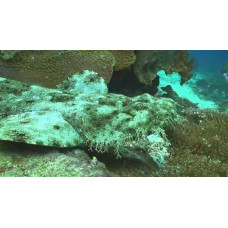Latin name
Orectolobus leptolineatus
Other names
Orectolobus leptolineatus
Identification
The Indonesian Wobbegong has a flattened and broad head and body. The nostrils are framed by branched antennae. The head is framed by a characteristic fringe of leathery scales. The tubercles and humps above the eyes are absent. The mouth has 23 upper rows of teeth. There is a rudimentary middle row on the symphysis of the upper jaw. The total number of vertebrae in the axial skeleton is 148-163.
Features of fish fins
Dorsal fins narrow, vertical. The base of the first dorsal fin begins above the beginning of the base of the pelvic fins. The distance between the dorsal fins is 0.5-0.8 of the length of the base of the anal fin. The inner edge of the anal fin is 0.7-0.7-0.0 of the length of the outer edge.
Fish colouring
The coloration is very mottled, with numerous thin dark brown stripes on the back, sides, and dorsal surface of the fins. The belly is uniformly pale.
Distribution
Indonesian Wobbegong are found in the western Pacific Ocean off the coasts of Indonesia, Borneo, possibly Taiwan, the Philippines and the Ryukyu Islands.
Habitat
Marine benthopelagic tropical species. Depth range 20-110 m.
Size
The maximum registered size is 112 cm.
Behavior
The depth range of this species is not well defined; specimens found in fish markets are thought to have been caught by longline fishermen working in deeper parts of the continental shelf. It probably prefers deeper and colder waters, as evidenced by isolated observations in shallow waters off the east coast of Bali, where cold-water upwelling is common.
Food and feeding habits
The diet of the Indonesian Wobbegong is thought to consist of bony fish, crustaceans and cephalopods.
Reproduction
All known males were over 90 cm long, the smaller of the two mature females was 94 cm long, and the two pregnant females were 104 and 108 cm long.
Fishing
The species is of interest to the local fishery.
Relationship with a person
The meat is used for human consumption. The International Union for Conservation of Nature has not assessed the conservation status of this species.
| Classification | |
| Phylum | Chordata |
| Class | Chondrichthyes |
| Squad | Orectolobiformes |
| Family | Orectolobidae |
| Genus | Orectolobus |
| Species | O. leptolineatus |
| Features | |
| Conservation status | Near Threatened |
| Habitat | Pelagic |
| Life span, years | No information |
| Maximum body weight, kg | No information |
| Maximum length, cm | 112 |
| Sailing speed, m/s | No information |
| Threat to people | Edible |
| Way of eating | Predator |
Indonesian wobbegong
Tags: indonesian wobbegong

